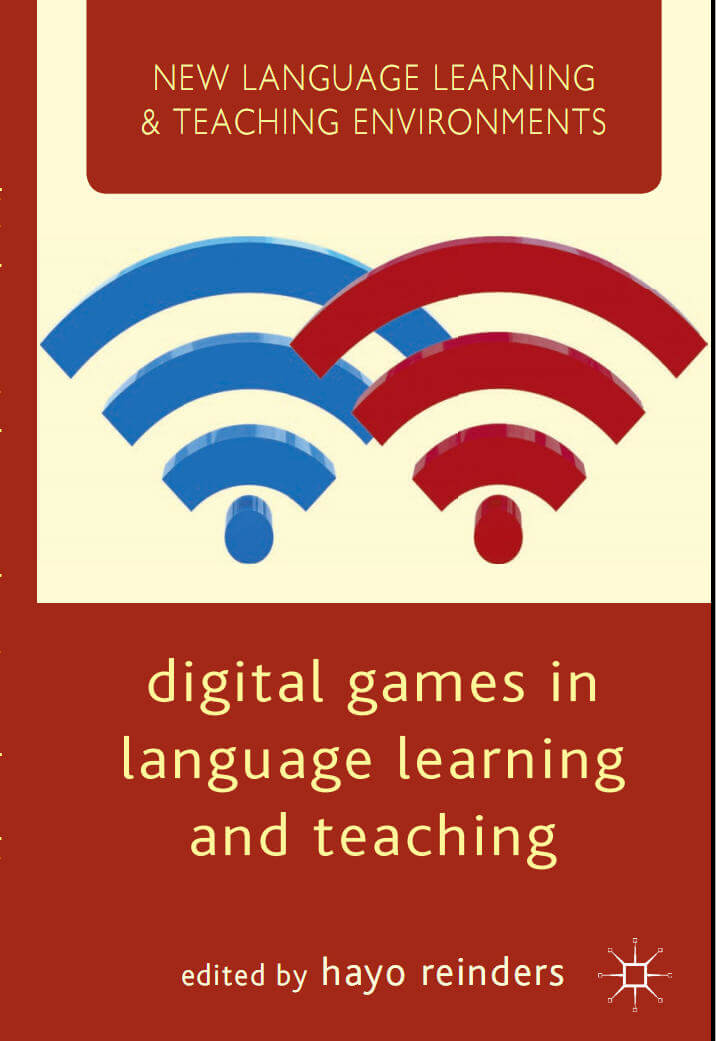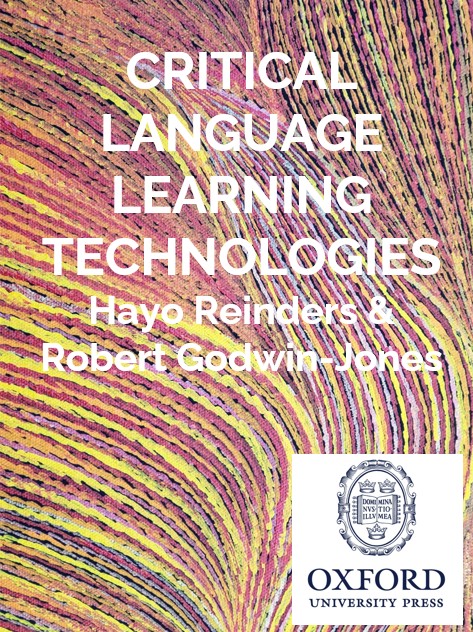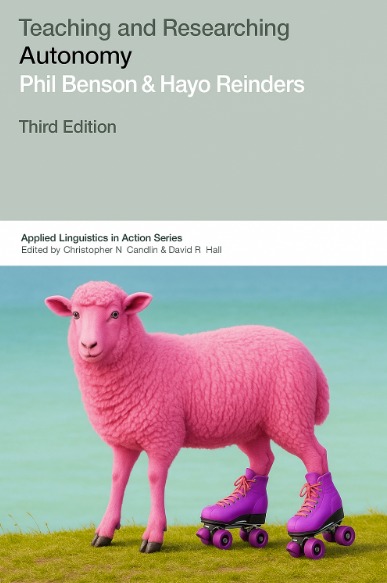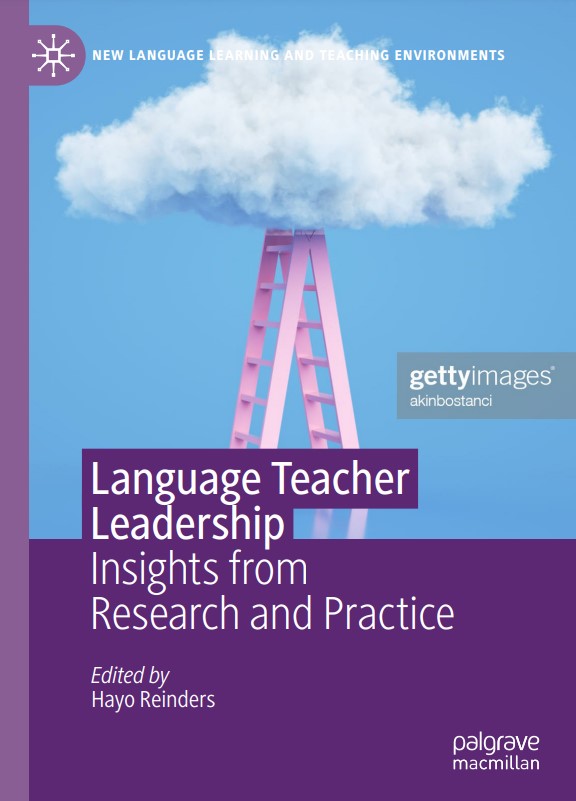Books > Digital games
Reinders, H. (Ed.). (2012). Digital games in language learning and teaching.Palgrave Macmillan.
This is one of the books in the ‘New Language Learning and Teaching Environments’ series I edit.

“Digital Games in Language Learning and Teaching is timely indeed. It is an invitation to a barely discovered territory. But there will, I predict, soon be a land rush.”
James Paul Gee
Table of contents
James Paul Gee
Foreword
Hayo Reinders
Introduction
From theory to practice
Michael Thomas
Contextualising Digital Game-based Language Learning: Transformational Paradigm Shift or Business as Usual?
Jon Reinhardt and Julie Sykes
Conceptualizing digital game-mediated L2 learning and pedagogy: game-enhanced and game-based research and practice
Michael Filsecker and Judith Bündgens-Kosten
Behaviorism, Constructivism, and Communities of Practice: How pedagogic theories help us understand game-based language learning
Mark Peterson
Language learner interaction in a massively multiplayer online role-playing game (MMORPG)
From practice to theory
Alice Chik
Digital gameplay for autonomous foreign language learning: Gamers and language teachers’ perspectives
Tanner Jackson, Kyle Dempsey, and Danielle McNamara
Game-based Practice in a Reading Strategy Tutoring System: Showdown in iSTART-ME
Robert Reichle
Sprites and Rules: What ERPs and procedural memory can tell us about video games and language learning
Hayo Reinders and Sorada Wattana
Talk to me! Games and students’ willingness to communicate
Pia Sundqvist and Liss Kerstin Sylven
World of VocCraft: Computer games and Swedish learners’ L2 English vocabulary
Shaoqun Wu, Margaret Franken and Ian H. Witten
Collocation games from a language corpus
Introduction
Hayo Reinders
Recent years have seen a growing interest in the pedagogical potential of digital games. The educational value of games has long been recognised (e.g. Lee 1979), but digital games in particular are now recognised to have great potential to engage learners and to encourage interaction in the target language. Immersive environments offer learners opportunities for situated learning and the adaptive qualities of most games ensure that learners are motivated to persist in their learning, thus increasing the chance of further exposure to target language input, and opportunities for output. The use of computer games in language education is based on the premise that successful learning is integrated into the sociocultural context of learners’ lives and encourages collaboration and lifelong learning. The use of new technologies, and in particular digital games, thus facilitates the bridging of learning within and outside the language classroom.
The authors of this collection, notwithstanding the diversity of their contributions, are united in their belief that the rationale for any instructional intervention, including the use of games, should be pedagogically sound. All agree that it is important to critically investigate the potential of digital games, not just from a general, but also from a specific second language learning and teaching perspective. Do games really motivate learners? Do they actually encourage more use of the target language? Do they offer opportunities for negotiation of meaning, or focus on form? Do they result in greater uptake and acquisition? Although some recent studies have started to address such questions (for example deHaan, Reed and Kuwada 2010, Piirainen-Marsh 2009, and Zheng, Young, Brewer and Wagner 2009), this is the first dedicated collection of papers to bring together the state-of-the-art in research into digital game-based language learning. But this collection does more than only present new research; it also actively makes links with the practice of teaching and supporting learning by reporting on innovative use of technology in language education in a range of settings.
A good starting point for investigating the affordances offered by digital games is to look at their characteristics. Prensky (2001) argues that most games involve the inclusion of:
1) rules
2) goals and objectives
3) outcome and feedback
4) conflict, competition, challenge, and opposition
5) interaction
6) the representation of a story.
These are also characteristics of many successful language teaching environments, and indeed (perhaps with the exception of the ‘representation of a story’) of task-based language teaching, in particular as related to the use of technology (see Thomas and Reinders 2011 for a collection of papers on technology in task-based language teaching). Successful games mirror successful teaching insofar as they create environments that balance user/learner control with clear expectations, exploration with feedback, and ample opportunities for genuine interaction. This relationship between what we know about L2 instruction and acquisition, and what games can contribute to this, is explored in the first four chapters, in the section ‘from theory to practice’.
Michael Thomas begins by highlighting some of the potential benefits of games for language learning and teaching as identified over the years. He argues that this potential has not been fulfilled, partly because there is a disconnect between ‘traditional transmission pedagogies of the pre-digital age […] reliant on linear modes of learning reinforced by linear hierachies of control and information access’, and the inclusive, collaborative, and process-orientated affordances offered by digital technologies. Thomas goes on, however, to show that these are not necessarily as far apart as they might seem. Games can contribute to the implementation of pedagogic principles that are becoming increasingly mainstream, such as the use of tasks, authentic forms of interaction and collaboration, and community-based and situated learning. Most importantly perhaps, games place learners at the heart of the learning and teaching process and in this way may have an impact on language education as a whole .
Jonathon Reinhardt and Julie Sykes further investigate this potential impact through a critical review of research on games in language learning and teaching. They begin by distinguishing between game-based and game-enhanced L2 learning and pedagogy and argue that these offer four different, but complementary perspectives. They call for more research into the connections between learning and pedagogy, and between the role of the learner, the game designer, and the instructional context. Like Thomas, they see an important indirect benefit of using and researching games: ‘While we find both game-enhanced and game-based work to be compelling for L2LP, we believe it is game-informed insights, that is, understandings from research and practice in other, related fields, which have the strongest potential to transform L2LP, whether game-mediated or not.’
Michael Filsecker takes as his starting point a number of well-known learning theories to critically review several popular games. Filsecker shows how behaviourist approaches have heavily influenced game design with many games including reinforcement as a key tool. Although such games have a role to play, they ‘leave little space for teachers, social interaction and reflection’. Constructivism on the other hand places learners in a more central role and Filsecker gives examples of games where learners deal with more authentic situations and where they actively influence how a game plays out. Similarly, such games give teachers a more active role as faciliators of learning, but Filsecker argues that considerably more research is needed to better undertand such roles. Communities of practice approaches go one step further as ‘meaning is negotiated among the participants themselves while members of that community when taking up the values and belief system of an emergent community’ and many games now exist that are built around such communities. Filsecker concludes by arguing that research and practice should not be limited to any single theory as different ways of learning (and teaching) contribute to the learning process in different ways.
Mark Peterson focuses specifically on language learner interaction in massively multiplayer online role-playing games (MMORPG). He begins by describing the features of such games relevant for language acquisition, before reviewing current research on their use. Peterson goes on to describe an experimental qualitative study on the use of an MMORPG (NineRift) with Japanese EFL learners learners. Using discourse analysis of chat texts collected during game play, researcher observation, field notes, learner responses to pre- and post-study questionnaires, and interviews, it was found that learners were very active in their participation, more so than they commonly were during regular classroom instruction, and were engaging in dialogue exclusively in the target language. Perhaps equally importantly, participants enjoyed the learner-centred nature of the interaction.
Although studies such as Peterson’s show an important affective role for computer games, there is likely to also be a cognitive impact of learning to play computer games. Robert Reichle argues that both games and language are rule-governed and strongly procedural skills, and that the acquisition of game-playing skills and morphosyntactic rules are governed by shared memory resources. He reviews recent electrophysiological research investigating second language processing that has incorporated video games into the design and concludes that ‘language learners can be trained to a high enough level of proficiency that they exhibit nativelike brain signatures of morphosyntactic processing when the training game couples L2 morphosyntax with gameplay mechanics and simultaneously incorporates critical learning by featuring:
a) cooperation
b) competition
c) a requirement of successful learning in order to progress
d) feedback
e) meta-awareness of gameplay mechanics’
Reichle then proceeds to give examples of these elements in two popular games. The question that Reichle poses in his conclusion is how the rules of L2 morphosyntax can be combined with the mechanics of gameplay so that grammar can be proceduralized during the acquisition of gameplay skills. He offers a number of future directions and avenues for research.
In the second part of the book, ‘from practice to theory’, the authors report on the use of games in different educational settings, and identify principles and good practice from these. Alice Chik starts off by looking at the ways in which game players use games and game-related activities in their foreign language learning and how this helps them to assume more control over their learning and in this way develop their autonomy. Using a wide range of instruments, such as classroom discussions, learning histories, blog entries and stimulated recall sessions, she compares the perceptions of gaming of learners and teachers and finds that teachers have a more restricted view of the role of games. Whereas teachers do not envisage that games play an important role in learners’ language learning experience, learners themselves see games as offering significant opportunities for input and interaction, and – importantly – as a way of self-directing their learning, with the help of others. Chik argues for more research into the ways in which learners use games in out-of-class settings.
Taking this line of inquiry further, Pia Sundqvist and Liss Kerstin Sylvén present the results of three studies into the ways in which Swedish learners make use of games in non-formal settings and how this impacts on their acquisition of English vocabulary. The first of these was a longitudinal study into the effects of content and language integrated learning on vocabulary development. One of the main factors found to affect acquisition was the use by students of texts outside of school. To investigate what types of texts were most beneficial, a second study was conducted. In this it was found that out of school activities were positively correlated with L2 acquisition and that in particular more ‘active’ types of activities such as use of the internet and playing video games were more strongly correlated than more passive activities such as watching TV or listening to music. Boys were found to engage more in the former, girls more in the latter. A third study with younger learner showed broadly similar findings. Sundqvist and Sylvén’s paper has a number of important pedagogical implications; there were for example significant gender differences and especially weaker learners did not engage in out-of-class learning in general, and computer games specifically, as much as stronger learners. With this knowledge, it becomes important for educators to find ways to encourage broader participation.
One attempt to encourage such participation is offered by Tanner Jackson, Kyle Dempsey, and Danielle McNamara who describe the use of a game-based reading strategy tutoring system called iSTART-ME, designed to provide young adolescent to college-aged students with reading strategy training to better understand science texts. They describe how earlier studies had shown their intelligent tutoring system (ITS) for reading strategy development to be effective but not used as extensively by students as anticipated. In an attempt to increase the appeal of the system, a game-enhanced version was designed which ‘…provides students with opportunities to interact with texts, earn points, advance through levels, purchase in-game rewards, personalize a character, and play educational mini-games’. As was expected by the authors, a comparison of the original with the game-enhanced system showed the former to be more effective, but the latter to be more engaging. Jackson, Dempsey and McNamara argue for more longitudinal research to establish how engagement and acquisition develop over time.
Engagement is also an important element in the study by Sorada Wattana and Hayo Reinders. We investigated the relationship between game play and the quantity and quality of L2 interaction within the game, and were particularly interested in participants’ Willingness to Communicate in the target language, hypothesising that game play would be motivating and the game environment would provide a non-threatening environment, encouraging participants to interact more. In our study we modified an existing MMORPG (Ragnarok online) and gave participants a number of quests to complete that required them to communicate with other players, collaborate on shared tasks, exchange information and coordinate their actions. We found an overall high level of participation and an increasing willingness to communicate. Participants’ utterances did not, however, improve in complexity or accuracy, showing the need for alternative or additional instruction.
In the final chapter of the book Shaoqun Wu, Margaret Franken and Ian H. Witten describe an innovative project, called ‘Flax’, that generates games from the Google n-gram corpus. Teachers can select the difficulty level, form or set other parameters to generate games such as ‘collocation dominoes’ (where the last word of the previous collocation becomes the first word of the next collocation), ‘collocation matching’ (where the system selects a set of collocations with the same syntactic pattern, splits each into its left and right component, and shuffles the two sets of components), ‘common alternatives’, and ‘collocation guessing’. A comparison of the collocations generated from the Google corpus with those from the OED and BNC, shows the massive and diverse nature of the former. Wu, Franken & Witten argue that the FLAX system offers access to authentic and motivating language practice.
Conclusion
The chapters in this collection are varied and are testament to the fact that research into game-based language learning and teaching is still in its infancy. A number of commanalities and themes do emerge however; firstly, it is important to understand gaming as a social activity situated in students’ lives. Research such as that conducted by Chik and Sundqvist & Sylvén is beginning to shed light on the ways in which learners use games, especially in out-of-school settings, how they perceive gaming, and how this relates to language learning. As Chik has shown, mismatches exist between teachers’ and learners’ perceptions, and it is only on the basis of good understanding of actual practices that research and pedagogy can be developed. Similarly, as Sundqvist & Sylvén have shown, there are significant differences in the ways in which learners engage in out-of-class learning and the use of games. Good pedagogy relies, at the very least, on awareness of these differences and how they impact on the learning experience, and ultimately learning outcomes.
The learning experience through digital games is also not yet fully understood. As Peterson points out, games can have a major affective impact on the language learning process and more research is needed to understand how this takes place in practice.
At the same time, a key challenge for future studies is to make strong links with what we already do know about (language) learning and teaching. Reichle, for example, advocates building on studies of memory processes, Jackson, Dempsey and McNamara on research into strategy instruction, and Reinders & Wattana on studies of interaction and willingness to communicate. Other potentially fruitful areas include the role of teacher and peer-feedback, the occurrence of focus on form in informal settings, the quality and quantity of input and opportunities for extended output in game settings.
Despite the potential evident from the contributions in this book, we would like to end on a cautionary note. Games are only one element in a much larger ecology of learning and teaching and need to be understood and developed as such. As we learn more about how games are used, the affordances they offer, as well as the limitations they impose, our findings need to be brought back into the wider body of knowledge of learning and teaching. Although insights from game-based learning will undoubtedly change that body of knowledge, the use of games needs to be informed by the principles and practice of second language acquisition. Perhaps the greatest contribution the authors in this collection have made is to show the many ways that game-based learning is connected to language learning and teaching research and practice, and does form an importantly (although not always yet realised) part of its future direction.
References
de Haan, J., Reed, M., & Kuwada, K. (2010). The effect of interactivity with a music video game on second language vocabulary recall. Language learning & technology, 14(2), 74-94.
Piirainen-Marsh, A., & Tainio, L. (2009). Other-Repetition as a Resource for Participation in the Activity of Playing a Video Game. The Modern Language Journal, 93(2), 153-169.
Prensky, M. 2001. Digital game-based learning. New York: McGraw-Hill.
Zheng, D., Young, M. F., Wagner, M., & Brewer, B. (2009). Negotiation for action:
English language learning in game-based virtual worlds. The Modern Language
Journal, 93(4), 489-511.
Foreword to Computer Games in Language Learning and Teaching
James Paul Gee
Mary Lou Fulton Presidential Professor of Literacy Studies
Arizona State University
There is something of a rage these days for game-based learning in and out of schools. In previous work I have stressed how good video games create good learning conditions. But this also amounts to saying they “teach” in a powerful way. However, the teaching method they use can be implemented with or without games, though games are one good platform with which to deliver such teaching.
How do good video games teach?
• They focus on well-ordered problems, not facts and information.
• They give players good tools with which to solve the problems (including other players in multiplayer gaming and facts and information as tools).
• They have clear goals, but, nonetheless, encourage players to rethink their goals from time to time.
• They lower the cost of failure so that players will explore, take risks, seek alternative solutions, and try new styles of play and learning.
• They put performance before competence and they put experiences and actions before words and texts. This means players learn by doing and that they have images and experiences to give deep meaning to the words and texts they read later in order to resource their play and learning.
• They give copious feedback and they assess all along the way to ensure that the player is always well prepared for what comes next.
• They connect playing and learning to social interaction and mentoring through collaborative and competitive play, as well as through interest-driven fan sites where players can extend and articulate their knowledge and even produce new knowledge and designs.
• They ensure that at each new level, players face new problems that challenge the routine mastery they have developed through lots of practice on the last level (this has been called “the cycle of expertise”).
• They use narrative in two ways to create engagement. They often have stories that make clear why the players are doing what they are doing and what it means. And they allow players to create their own stories through the consequential choices they have made in the course of game play.
• They hold everyone to the same high standard (everyone, for example, fights the same “bosses”), but allow players to reach these standards in different ways and in different amounts of time (so it does not really matter where or when one started, only where one finishes).
• They deal with transfer as “preparation for future learning.” You can see how well players have learned by seeing how well they do in similar later and harder games or problems in life.
• Gamers have to think like designers even to play, since they have to figure out how the “rule system” in the game works and how it can be used to accomplish their goals. They can go further and “mod” the game (make new levels or versions) by using the design software by which the game was made.
We do not have a name for such teaching, teaching that is designing, though it is increasingly pervasive out of school. So let’s just call it Teaching as Designing (TAD).
There has been over the last few years a quite specific interest in using games to teach language and literacy. It should be clear that TAD is a good deal closer to how people acquire new languages in situ, rather than in standard classrooms with textbooks or drill sheets. And we should be clear that learning a language and learning literacy are problem solving activities when and if they are to become real skills and not just test passing skills. Learners need to use the language or literacy skills they are learning to carry out communicative or cognitive goals, actions, and functions that are consequential to them.
Good video games have design features that are particular relevant to language learning. They often use “concentrated samples”. Concentrated samples are situations where you present players or learners with many more instances in a short time of important cases than they would see in reality. This is an important tool in language and literacy learning. Good games can lower the affective filter by creating engagement and situations where learners’ fears are by-passed. Good games can create talk and text both in the game and outside of it in an interest-driven site where players discuss the game, game play, and problem solving, gaining meta-cognitive and meta-linguistic skills. Games can create hours of practice by placing lower-level skills inside larger more motivating and engaging problems.
But the main thing games can do for language learning is to “situate meaning”. Games associate words with images, actions, goals, and dialogue, not just with definitions or other words. Learners come to see how words attach to the world’s (contexts, situations) they are about and help to create or manipulate. If learners can only “cash out” words for words, they have a purely verbal understanding of talk and texts. This may be good for test passing, but it is not good for deep understanding. If they can “cash out” words for images, experiences, actions, goals, and dialogue—for a virtual theater motivated action in their minds—then they have deep understanding and real learning.
Digital Games in Language Learning and Teaching is timely indeed. It is an invitation to a barely discovered territory. But there will, I predict, soon be a land rush.


